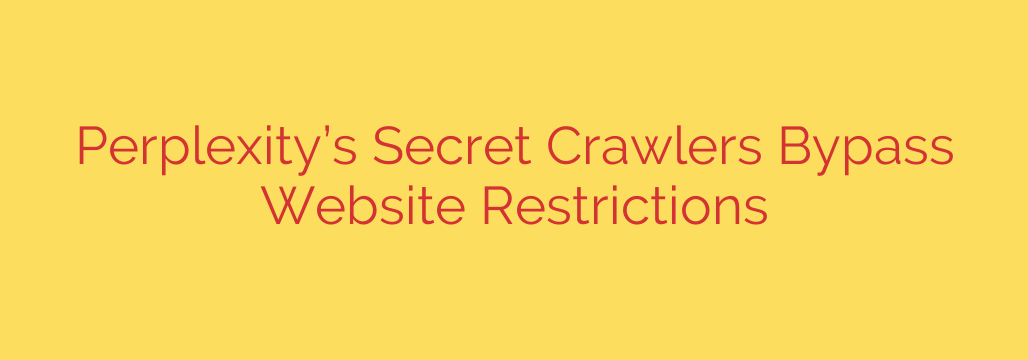
The Silent Scrapers: Are AI Crawlers Ignoring Your Website’s Rules?
For decades, the internet has operated on a delicate system of trust. At the heart of this system is a simple text file: robots.txt. This file is a website owner’s way of politely telling search engines and other automated bots which parts of their site they are welcome to visit and which are off-limits. For legitimate crawlers like Googlebot, this protocol is the established rule of the road.
However, a new wave of aggressive data collection, driven by the insatiable appetite of AI models, is threatening to undermine this long-standing agreement. Reports are surfacing that certain AI-powered search companies are deploying web crawlers that blatantly disregard robots.txt directives, accessing and scraping content from areas that webmasters have explicitly restricted.
This isn’t just a minor breach of etiquette; it represents a significant challenge to content creators, website owners, and the principle of digital consent.
The robots.txt Protocol: A Gentleman’s Agreement
Before diving into the problem, it’s essential to understand what robots.txt is—and what it isn’t.
- It’s a Guideline, Not a Wall: The
robots.txtfile is a public request. It relies on the “good faith” of the bot to follow its instructions. It does not, by itself, physically block access to your content. - It Manages Crawler Traffic: Webmasters use it to prevent crawlers from indexing private directories, overwhelming servers with requests, or scraping sensitive information.
- It’s a Foundational Web Standard: Major search engines have respected this protocol for years, fostering a predictable environment for both publishers and search providers.
The problem arises when new players decide these rules don’t apply to them. Driven by the need to train Large Language Models (LLMs), some AI companies are taking a more aggressive approach to data gathering.
Bypassing the Rules for AI Training Data
The core of the issue lies in how some modern AI crawlers are operating. According to detailed investigations and server log analysis from multiple sources, these bots are engaging in questionable practices.
One of the primary methods involves using undocumented or intentionally vague user agents. A user agent is a string of text that a bot uses to identify itself to a web server. When a company uses a hidden or unofficial user agent, it makes it incredibly difficult for webmasters to identify the source of the traffic and block it.
This effectively allows the AI crawlers to operate in stealth mode, vacuuming up entire websites’ worth of content without permission. By ignoring robots.txt and hiding their identity, these operations bypass the explicit wishes of the content creators.
Why This Is a Serious Problem for Your Website
This practice has several damaging consequences for anyone who runs a website:
- Violation of Consent and Intellectual Property: You have set clear boundaries for how your content should be accessed. When a crawler ignores these rules, it’s a form of digital trespassing that uses your work without permission to build a commercial product.
- Increased Server Load and Costs: Aggressive, high-volume crawling can put a significant strain on your server’s resources. This can lead to slower page load times for your actual human visitors and potentially higher hosting bills due to increased bandwidth consumption.
- Erosion of Web Standards: If a major AI company successfully ignores
robots.txtwithout consequence, it sets a dangerous precedent. This could encourage other bad actors to do the same, leading to a “wild west” of data scraping where website owners lose all control.
Actionable Security: How to Protect Your Website from Unwanted Crawlers
Since relying on robots.txt is no longer sufficient, webmasters need to adopt a more proactive and layered security posture. Here are concrete steps you can take to defend your content.
Block Known Bad User Agents: While some crawlers hide their identity, others have been identified. You can block specific user agents at the server level. For instance, to block the known crawler from one such AI company, you can add rules to your
.htaccessfile (for Apache servers) or server configuration. A common user agent to block isPerplexityBot.Leverage a Web Application Firewall (WAF): This is arguably the most effective solution. Services like Cloudflare, Sucuri, or Imperva offer sophisticated bot management systems. A WAF can analyze traffic behavior, not just its stated user agent. It can identify and challenge or block automated traffic that behaves like an aggressive scraper, regardless of how it identifies itself. A WAF with advanced bot protection is your strongest line of defense.
Monitor Your Server Logs: Regularly check your website’s access logs. Look for patterns of high-frequency requests from a single IP address or a suspicious user agent. If you find a bot that is ignoring your
robots.txtrules, you can block its IP address directly. Be aware, however, that sophisticated crawlers often rotate through a vast pool of IP addresses.Implement Rate Limiting: Configure your server to temporarily block IP addresses that make an unusually high number of requests in a short period. This can thwart aggressive crawlers and protect your site from being overwhelmed.
The internet is evolving, and the rise of AI has introduced new challenges. The “gentleman’s agreement” of robots.txt is being tested like never before. For content creators and website owners, the message is clear: trust is not enough. It’s time to implement robust, technical defenses to protect your intellectual property and ensure your website remains performant for the audience you intend to serve.
Source: https://blog.cloudflare.com/perplexity-is-using-stealth-undeclared-crawlers-to-evade-website-no-crawl-directives/








